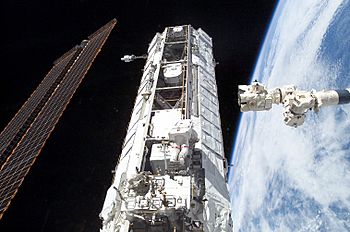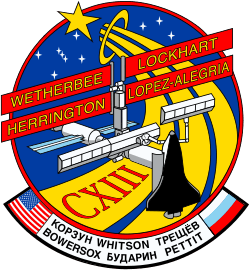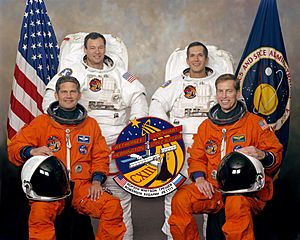STS-113 facts for kids

Lopez-Alegria climbs the newly-installed P1 truss during the mission's second EVA
|
|
| Mission type | ISS assembly Crew rotation |
|---|---|
| Operator | NASA |
| Mission duration | 13 days, 18 hours, 48 minutes, 38 seconds |
| Distance travelled | 9,000,000 kilometres (5,600,000 mi) |
| Spacecraft properties | |
| Spacecraft | Space Shuttle Endeavour |
| Launch mass | 116,460 kilograms (256,750 lb) |
| Landing mass | 91,498 kilograms (201,719 lb) |
| Payload mass | 12,477 kilograms (27,507 lb) |
| Crew | |
| Crew size | 7 |
| Members |
|
| Launching |
|
| Landing |
|
| Start of mission | |
| Launch date | 24 November 2002, 00:49:47 UTC |
| Launch site | Kennedy LC-39A |
| End of mission | |
| Landing date | 7 December 2002, 19:38:25 UTC |
| Landing site | Kennedy SLF Runway 33 |
| Orbital parameters | |
| Reference system | Geocentric |
| Regime | Low Earth |
| Perigee | 379 kilometres (235 mi) |
| Apogee | 397 kilometres (247 mi) |
| Inclination | 51.6 degrees |
| Period | 92.3 min |
| Docking with ISS | |
| Docking port | PMA-2 (Destiny forward) |
| Docking date | 25 November 2002, 21:59 UTC |
| Undocking date | 2 December 2002, 20:50 UTC |
| Time docked | 6 days, 22 hours, 51 minutes |
  (L-R): Paul S. Lockhart, Michael E. López-Alegría, John B. Herrington, and James D. Wetherbee |
|
STS-113 was a Space Shuttle mission to the International Space Station (ISS). The Space Shuttle Endeavour flew this important mission in late 2002. It lasted for 14 days.
During STS-113, Endeavour and its crew added a new part to the ISS. This part was called the P1 truss. The mission also swapped out the crews living on the station. The Expedition 5 crew returned to Earth, and the Expedition 6 crew began their stay.
Commander Jim Wetherbee and Pilot Paul Lockhart guided Endeavour. The shuttle docked with the ISS on November 25, 2002. For seven days, the crew worked on building the station. They also did spacewalks and moved equipment. This was the last flight for Endeavour before it got major upgrades. It was also the last shuttle mission before the Columbia accident.
Contents
Meet the Crew of STS-113
The STS-113 mission had a crew of seven astronauts. Some astronauts went up to the ISS to live there. Others came back down to Earth.
| Position | Launching Astronaut | Landing Astronaut |
|---|---|---|
| Commander | James D. Wetherbee Sixth and last spaceflight |
|
| Pilot | Paul S. Lockhart Second and last spaceflight |
|
| Mission Specialist 1 | Michael López-Alegría Third spaceflight |
|
| Mission Specialist 2 | John B. Herrington Only spaceflight |
|
| Mission Specialist 3 | Kenneth D. Bowersox Expedition 6 Fifth and last spaceflight ISS Commander |
Valery G. Korzun, RKA Expedition 5 Second and last spaceflight ISS Commander/Soyuz Commander |
| Mission Specialist 4 | Nikolai M. Budarin, RKA Expedition 6 Third and last spaceflight ISS Flight Engineer/Soyuz Commander |
Peggy A. Whitson Expedition 5 First spaceflight ISS Flight Engineer |
| Mission Specialist 5 | Donald R. Pettit Expedition 6 First spaceflight ISS Flight Engineer |
Sergei Y. Treshchov, RKA Expedition 5 Only spaceflight ISS Flight Engineer |
One special crew member was John Herrington. He became the first enrolled member of a Native American tribe to fly in space. Another astronaut, Gus Loria, was supposed to be the pilot. But he was replaced by Paul S. Lockhart before the mission.
Key Moments of the Mission
STS-113 was an important mission for building the International Space Station. It delivered a large part called the P1 Truss. This truss helps support the station's radiators, which keep it cool.
Spacewalks to Build the ISS
Mission Specialists John Herrington and Michael López-Alegría performed three spacewalks. During these spacewalks, they worked outside the station. They activated and prepared the new P1 truss. The crew also moved a lot of cargo between the shuttle and the station. They transferred about 1,969 kilograms (4,340 pounds) of supplies.
| Mission | Spacewalkers | Start – UTC | End – UTC | Duration | What They Did | |
|---|---|---|---|---|---|---|
| 47. | STS-113 EVA 1 |
Michael López-Alegría John Herrington |
26 November 2002 19:49 |
27 November 2002 02:34 |
6 h, 45 min | Installed the P1 truss |
| 48. | STS-113 EVA 2 |
Michael López-Alegría John Herrington |
28 November 2002 18:36 |
29 November 2002 00:46 |
6 h, 10 min | Installed TV cameras, moved CETA |
| 49. | STS-113 EVA 3 |
Michael López-Alegría John Herrington |
30 November 2002 19:25 |
1 December 2002 02:25 |
7 h, 00 min | Inspected the Mobile Transporter |
Crew Exchange and Return to Earth
STS-113 brought the Expedition 6 crew to the station. They stayed there for about four months. The Expedition 5 crew, who had been in space for 185 days, returned to Earth on Endeavour.
The mission ended when Endeavour landed at Kennedy Space Center on December 7. This was the 19th flight for Endeavour. It was also the 112th Space Shuttle mission overall. This mission was the 16th time a shuttle visited the ISS. It was the first time a mission landed on the fourth day of landing attempts.
Other Interesting Facts
- STS-113 carried a small experiment called MEPSI. This stands for Micro-Electromechanical System based Pico Satellite Inspector. It released two tiny satellites connected by a 15 metres (49 ft) tether.
- This was the last successful Space Shuttle mission before the Columbia accident (STS-107).
- STS-113 was the last mission where Russian cosmonauts flew on the Space Shuttle.
- It was also the last shuttle mission to fly with an older, analog-style cockpit. After the Columbia accident, Endeavour received modern cockpit upgrades.
Images for kids
-
Landed Expedition 5 crew
L-R: Valery G. Korzun, Peggy Whitson, and Sergei Y. Treshchev
See also
 In Spanish: STS-113 para niños
In Spanish: STS-113 para niños






